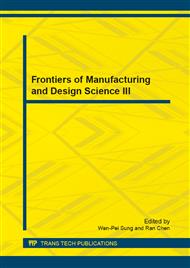p.255
p.259
p.263
p.268
p.272
p.277
p.283
p.288
p.292
Optimising Injection Moulding Parameter Setting in Processing Polypropylene-Clay Composites through Taguchi Method
Abstract:
The main purpose of this research is to optimise the injections moulding parameters in processing of thermoplastics samples made from Polypropylene (PP)-Clay with the fraction of 95% PP and 5% Clay, through Design of Experiment -Taguchi Method. The selection of defects or responses that need to be controlled for these thin layer products were warpage and shrinkage. The parameters that were taken into consideration were packing pressure; melt temperature, screw speed and filling time. In this research, the L934 orthogonal from Taguchi Method was chosen as the experiment setup. According to the results, 170°C of melt temperature, 80% of packing pressure, 70% of screw speed and 3 seconds of filling time gave minimum shrinkage of 3.45%. As for the warpage results, the best parameters combinations are 170°C of melt temperature, 70% of packing pressure, 70% of screw speed and 2 seconds of filling time. The Analysis of Variance for warpage shows that screw speed was the most significant factor with 41.83% contribution. As for shrinkage, the most influential factor was packing pressure with 98.48% contribution. Two factors have been pooled which are screw speed and filling time. Based on these findings, it is concluded that by controlling the optimum parameter setting, the best quality of desired product can be easily achieved and maintain through the in process production.
Info:
Periodical:
Pages:
272-276
Citation:
Online since:
December 2012
Price:
Сopyright:
© 2013 Trans Tech Publications Ltd. All Rights Reserved
Share:
Citation:


